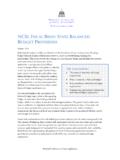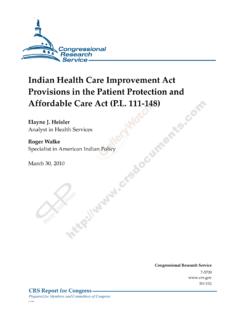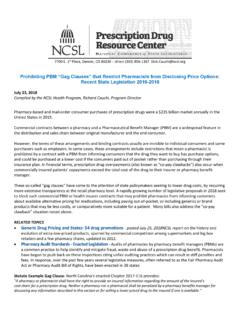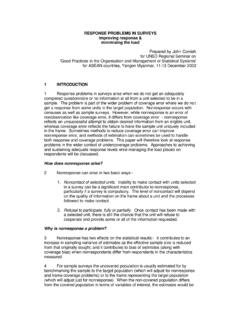Transcription of Improving the Health Care System: Seven State Strategies
1 BY JULIA C. MARTINEZ, MARTHA P. KING AND RICHARD CAUCHII ntroduction The Health system faces challenges including inefficiencies, escalating costs and variations in Health care quality, access and results. Wide agreement exists that the system needs transform-ing. A reformed system would deliver better care at lower costs without disparities from one Health organization and community to another. It would reward value before volume, quality before quantity and organized delivery over disorganized It would also focus on patient needs and safety as top Health care costs have grown faster than the overall economy for decades and continue to rise at a rapid rate after a brief slowdown during the Great Recession. Health spending comprises the largest share of the federal budget more than defense spending2 and is expected to account for 20 percent of the gross domestic product by Globally, Health spending is in a league of its own, totaling $3 trillion.
2 Per-person Health care costs are higher than in any other country, yet Ameri-cans are not notably healthier than people in other industrialized and post-industrial expenditures accounted for roughly 32 percent of the average State s budget in 2012 (including federal funds, most notably for Medicaid). State governments are often the largest Health care purchaser within their borders. With Health costs ris-ing by two to three times the Consumer Price Index, it is difficult for states many still dealing with budget challenges after the re-cession to maintain the programs they have, let alone undertake Strategies to cover additional uninsured Inefficiencies. Inefficiencies in the Health care system in other words, waste account for a big share of the cost problem. Experts suggest that addressing just a fraction of this problem, without cutting appropriate care, would go a long way toward controlling and containing costs and Improving the overall Health system .
3 The American Medical Association lists six categories of waste: overtreatment, failure to coordinate care, failures in processes that execute care, administrative complexity, pricing failures (such as wide variations in charges for proce-dures and lack of transparency) fraud and In a 2012 report, the Institute of Medicine (IOM) calculated that about 30 percent of Health care spending in 2009 or some $750 billion a year was wasted on unnecessary services, exces-sive administrative costs, fraud and other problems. 7 Examples of unnecessary services or misuse include providing primary care services in emergency rooms, prescribing antibiotics for upper respiratory infections that do not respond to medications and per-forming cesarean-section births when not medically necessary. Variations in the rates of coronary bypass surgery, back surgery Strong states , Strong NationJULY 2016 Improving the Health Care system : Seven State Strategies2 | Improving the Health Care system : Seven State StrategiesNational Conference of State Legislaturesand hip replacements often vary by geogra-phy rather than by medical IOM report recommended, among other things, refashioning payment systems to emphasize the value and outcomes of care, rather than volume.
4 Under the tradi-tional fee-for-service (FFS) model, providers and hospitals set their own fees and charge for every office visit, admission, test, pro-cedure and medication. Critics of fee-for-service reimbursement argue that it rewards providers for volume and profitability of ser-vices, rather than for quality and efficiency, thereby encouraging unnecessary areas for improvement. Many other causes contribute to the high price of Health care, including lack of transparency in pricing and defensive medicine, where physicians order tests and procedures not primarily to ensure the Health of the pa-tient, but as a safeguard against possible medical malpractice liability. Pressure from employers and insurers for transparent pricing is beginning to prod providers and hospitals to explain or eliminate hard-to-justify price variations , hip replace-ment procedures.
5 The average cost of a hip replacement in Montgomery, Alabama was $16,399, compared to the $55,413 it cost in Ft. Collins-Loveland, Colorado, over a 36-month period ending in Defen-sive medicine also adds to the escalating cost of Health care because doctors tend to order extra tests and procedures to avoid malpractice lawsuits. Promising reforms. Incremental efforts over the years by State and federal policy-makers, employers, Health care providers and advocates have helped expand access, improve efficiencies and involve patients more fully in their own care decisions. In-cremental efficiency efforts have focused on reducing errors, enforcing practice guide- State ScorecardThe Commonwealth Fund s Scorecard on State Health system Performance looks at 42 specific Health indicators grouped under five broad Health care areas.
6 Access and affordability prevention and treatment hospital use and costs healthy lives equity issuesNumber of Indicators Improved or Worsened WORSENED IMPROVED71112111198812101168869101316611 1188119105128998101171411514691365861111 5100553221432124423213332424413234231152 23331242423537 AlabamaAlaskaArizonaArkansasCaliforniaCo loradoConnecticutDelawareDistrict of ColumbiaFlorida GeorgiaHawaiiIdaho Illinois IndianaIowa KansasKentuckyLouisianaMaineMarylandMass achusettsMichiganMinnesotaMississippiMis souriMontanaNebraskaNevadaNew HampshireNew JerseyNew MexicoNew YorkNorth CarolinaNorth DakotaOhioOklahomaOregonPennsylvaniaRhod e IslandSouth CarolinaSouth DakotaTennesseeTexasUtahVermont VirginiaWashingtonWest VirginiaWisconsinWyomingSOURCE: THE COMMONWEALTH FUND, 201510 National Conference of State LegislaturesImproving the Health Care system : Seven State Strategies | 3lines, applying information technology across the entire Health system , attacking fraud and implementing malpractice reforms.
7 Electronic Health records and electronic prescriptions, although still limited, are Improving outcomes and reducing costly medi-cal errors. And, shifting the emphasis of providers and communi-ties toward prevention and healthy lifestyles can help restrain the growth in spending while Improving people s Health . More recently, pioneering efforts have begun to attack bigger areas, such as reforming entire payment and delivery systems. The Commonwealth Fund s 2015 Scorecard on State Health system Performance highlights improvements for numerous indi-cators between 2013 and 2014, such as increasing access to care; lowering the rate of patient deaths within 30 days of hospital discharge following heart attacks, heart failure and pneumonia; increasing childhood immunization rates; and decreasing smok-ing rates among adults.
8 The scorecard lists Connecticut, Hawaii, Massachusetts, Minnesota, New Hampshire, Rhode Island and Vermont as making headway across most dimensions of care be-tween 2013 and 2014. It also cites states that did well in individ-ual efficiency categories. For example, Alaska, Colorado, Idaho, Montana and South Dakota scored high for reducing overall costs by avoiding unneeded hospital readmissions and other inefficien-cies. But challenges remain. Several states showed declines in preventive care, and every State experienced higher average pre-miums in employer-sponsored Health insurance Health system that delivers quality care more affordably is possible. State legislatures play important roles in cutting waste-ful spending while Improving their own State s Health systems. This issue brief highlights Seven target areas and Strategies that have demonstrated results in states that are implementing them.
9 Policymakers may want to look at the following Strategies when considering system improvements in their own Shift the Payment Model 42 Dig Up the Data 73 Put the Patient First 104 Target the Sickest Patients 125 Treat the Whole Person 146 Invest in Prevention 177 Promote Safety and Prevent Medical Harm 194 | Improving the Health Care system : Seven State StrategiesNational Conference of State LegislaturesFEE FOR SERVICEThe traditional fee-for-service system pays for individual servic-es and volume, rather than emphasizing quality or results. Until recently, there has been little to discourage this expensive way of doing business or to motivate Health care providers to collaborate with each other to figure out the best and most cost-effective course of treatment for patients. Providers face mounting pres-sure from private and government insurers, employer groups and others to contain rising costs.
10 For 25 years, Health organizations and insurers have been looking for and experimenting with ways to change the system to one that pays for the value of care rather than each service and procedure,1 but it is a complex process that involves changing the way Health care is delivered. PAYMENT REFORM The federal government has taken the lead in nudging the payment reform process along. Medicaid and Medicare, which are testing different payment systems, including hybrid models that sometimes include fee for service, are exerting pressure, negoti-ating rates at a fraction of private-plan levels. The Depart-ment of Health and Human Services (HHS) has set aggressive targets of shifting at least 30 percent of fee-for-service Medicare payments to alternative quality or value payment models by this year, and shifting 50 percent of such payments by 2018.














